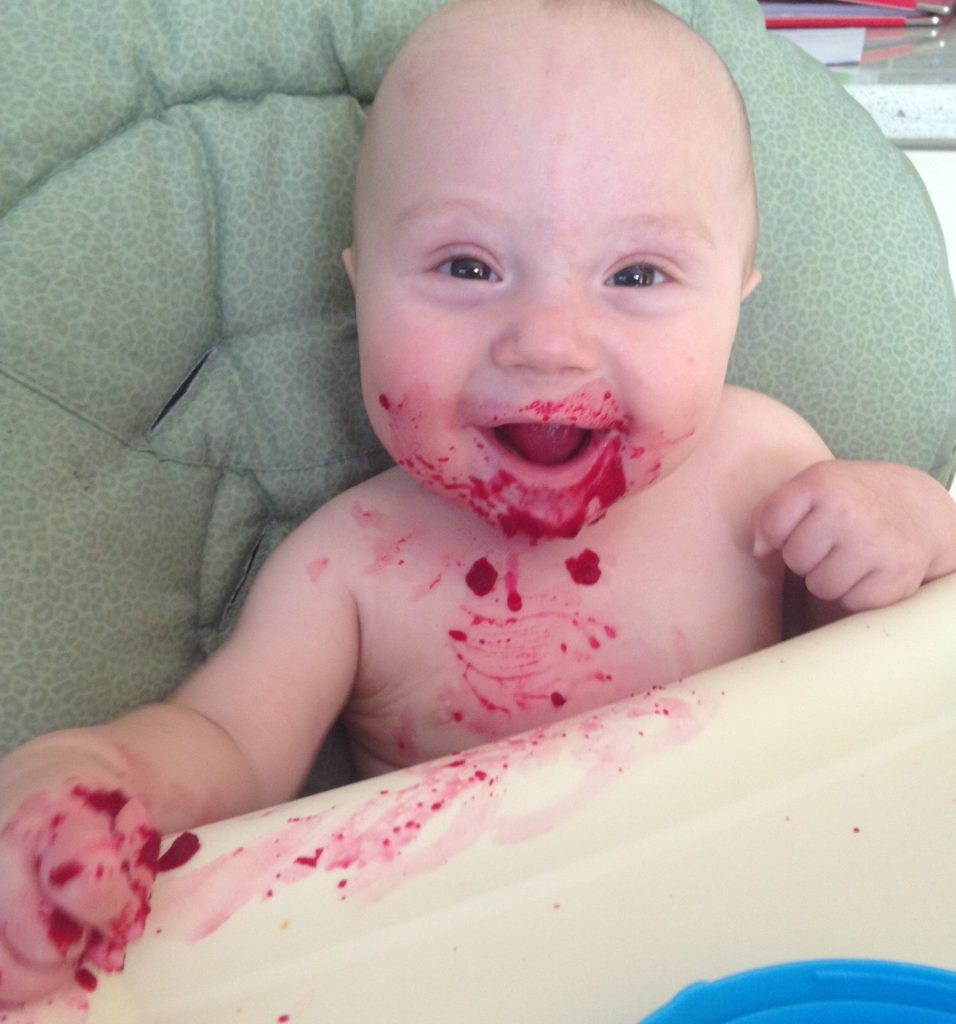
Get those hands dirty! The benefits of play are numerous, but unstructured, exploratory “messy play” allows your baby to make discoveries by using all her senses. The sensory experience of messy play enables your baby to understand how things feel, smell, and taste and gives her control over the experience. Playing with actual toys is fun and has its purpose, but your baby is restricted in how she can use toys, while messy play has endless possibilities.
Messy play also encourages language and communication as you interact with her during the experience.
Messy play is great for STEM! By offering your baby a variety of materials, he will use his natural curiosity to explore these unfamiliar items, using all his senses. He will be introduced to math concepts as he has the opportunity to investigate by pouring, filling, scooping, and sorting. He will be learning about the scientific properties of materials such as wet verses dry, warm verses cold, light verses heavy, etc. He will also learn cause and effect as he shakes, mixes, squishes, and squashes the materials.
Messy play is usually very engaging for your baby so it increases her attention span, focus, and concentration. These are really important skills for later on. It also can help with tactile sensitivity and body awareness as they process how things feel against their skin. Fine motor and visual motor skills are used in messy play as well as babies use their hands to make precise and controlled movements.
Preparation is the key to quick clean-up. We recommend using the high chair with a mat underneath to catch the mess. Allow time for clean-up as you will probably go straight to the bathtub.
At this age, we encourage messy play with edible substances only because it is all going in the mouth.
Here are some ideas:
- Edible finger paint – put one or two drops of Wilton food gels into plain greek yogurt (Greek yogurt is a little bit thicker than plain yogurt, so it is easier for your baby to manage). Mix up two or three different colors and put a dollop of each on his high chair tray. Encourage him to use his hands to swirl it around. Talk about the colors, texture, smell, feel (and taste) of the yogurt.
- Edible slime- mix equal parts cornstarch and water. You can add food coloring if you choose. Mix it with a spoon or your hands until you can scoop a handful and make a ball. It will then turn to liquid and drip through your hands. This can be very entertaining and you can ask questions such as, “Is it warm or cold? Is it soft or hard?”
- Sensory spaghetti -cover his tray with cooked and cooled noodles (you can even color them with food coloring).
- Jello fun- You can make your own with gelatin so you control the added colors. Put some jello on her tray and encourage her to squish it between her fingers. You could also use a cookie cutter to cut it into different shapes.
- Make natural play dough out of 1 cup organic flour, 1 cup water, 1-2 cups organic cornstarch, 1 tsp. cream of tartar, and 2 tbsp salt. and natural food coloring. Mix flour, cream of tartar, and salt in large bowl. Bring 1 cup of water to a boil over medium heat. Add the food dye.Transfer the colored water to the flour mixture and mix it in. Allow to cool, then mix in the cornstarch, a little bit at a time until the play dough is no longer sticky. Repeat this with other colors. When it is completely cooled, allow your baby to play with the play dough and provide a roller and cookie cutters to make shapes. Roll some into tiny balls and let him squish the balls between his thumb and index finger to practice isolated finger strength. Encourage him to press his hand into the dough and kneed it between two hands.
- Rice cereal paint- Mix water into rice cereal until is has a watery consistency. Add natural food coloring. Make two or three different colors and put it on his high chair tray or on a mat on the floor and allow him to finger paint. You could also give him a clean, new, wide paint brush with bristles (avoid foam brushes because your baby could bite off a chunk and avoid slender brushes that he could put too far into his mouth). Show him how to use the paint brush to paint his arms and legs as you say his body parts. This is great for body awareness and processing tactile sensation.
References:
Kranowitz, C. (2003). The Out of Sync Child Has Fun. Penguin Group, NY, NY.
Ayres, A. J. Sensory integration and learning disorders. Los Angeles: Western Psychological Services, 1973.

